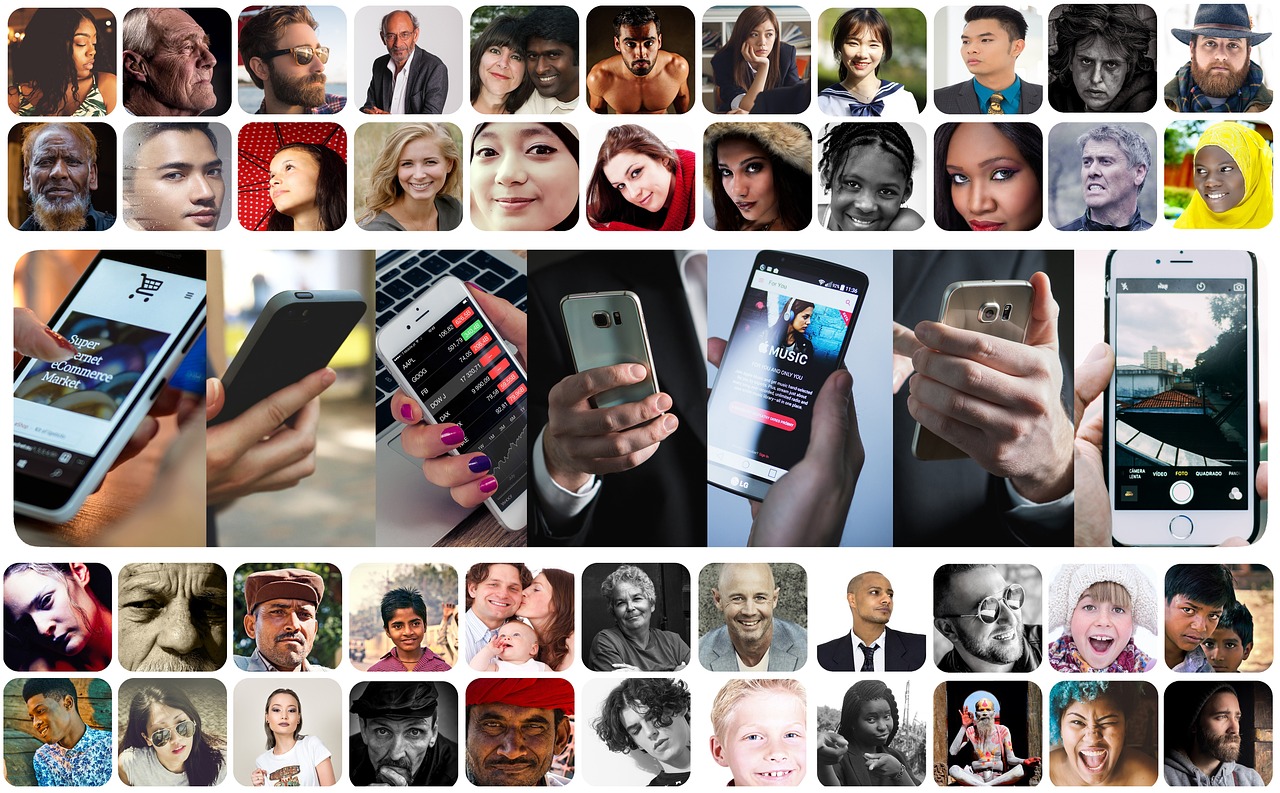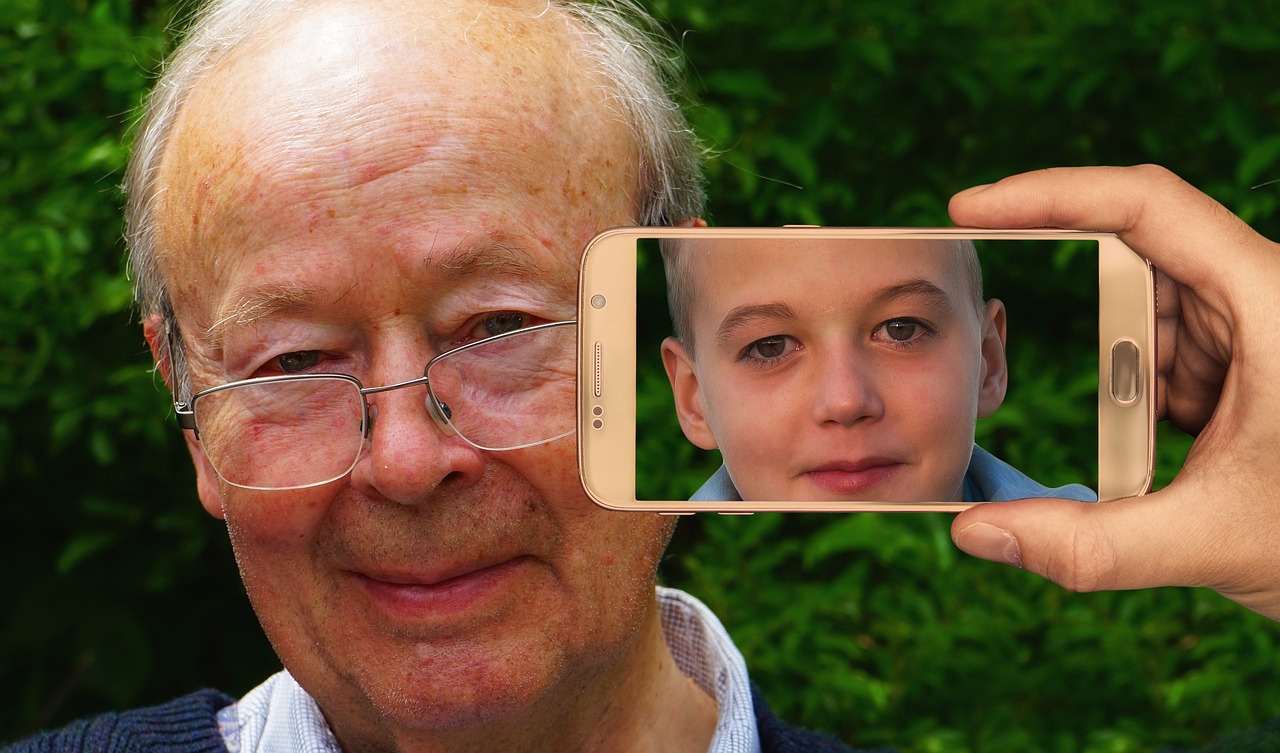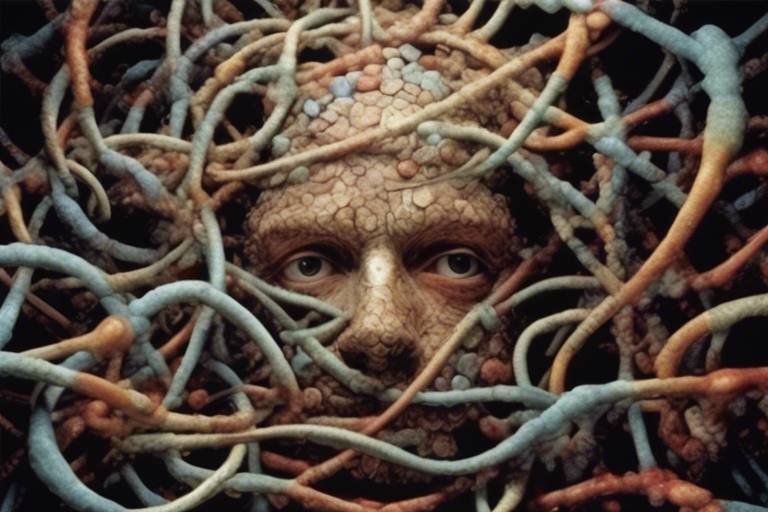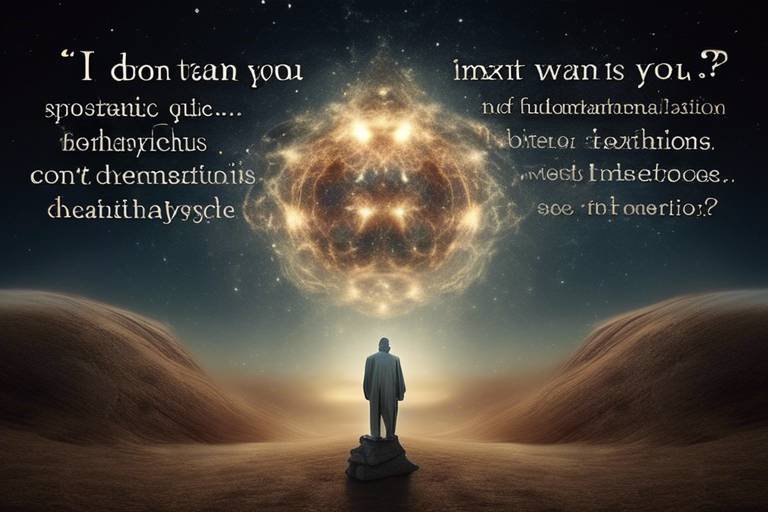Ontology in Virtual Reality: A Critical Analysis
In today's rapidly advancing technological landscape, the convergence of ontology and virtual reality (VR) is creating a fascinating tapestry of possibilities. Ontology, at its core, is the philosophical study of being and existence. When we apply this concept to the realm of virtual reality, we find ourselves delving into how entities are categorized and represented in immersive digital spaces. This exploration is not just academic; it has profound implications for the way we interact with virtual environments, shaping everything from game design to training simulations.
The significance of ontology in VR cannot be overstated. It serves as the backbone for creating meaningful interactions within virtual worlds. Imagine stepping into a VR environment where every object behaves as you would expect it to based on its real-world counterpart. That’s the magic of ontology at work! By establishing clear definitions and relationships between virtual entities, designers can create experiences that feel intuitive and engaging. This leads to a more immersive experience, where users can focus on exploration rather than struggling to understand the rules of the virtual space.
As we venture further into this analysis, it’s essential to recognize that ontology is not a one-size-fits-all solution. There are various types of ontologies, each tailored to specific needs. For instance, domain-specific ontologies are designed for particular industries, such as healthcare or gaming, allowing for customized virtual experiences that cater to the unique demands of users in those fields. On the other hand, upper ontologies provide a broad framework that can unify different domains, fostering interoperability and consistency across diverse virtual environments. This distinction is crucial for developers who wish to leverage ontology effectively in their projects.
However, the road to implementing ontology in virtual reality is not without its hurdles. One of the primary challenges is the inherent complexity involved in designing these systems. Developers must navigate a landscape filled with diverse data sources, all while striving for a standardized approach that can be universally applied. The need for collaboration among stakeholders in the VR community is paramount to overcome these challenges. This is where the integration of ontology with emerging technologies, such as artificial intelligence and machine learning, can play a transformative role.
Looking ahead, the future trends in ontology and VR are poised to redefine user experiences. With the integration of AI, virtual environments can become more adaptive, responding to user behaviors and preferences in real-time. This dynamic interaction not only enhances engagement but also fosters a sense of agency for users within the virtual space. Additionally, as user-generated content continues to flourish, the challenge of maintaining coherence in ontology becomes even more pressing. Developers will need to create flexible frameworks that can accommodate a variety of inputs while ensuring that the virtual environment remains cohesive and navigable.
In conclusion, ontology is a critical component in the evolution of virtual reality. Its role in defining interactions and categorizing entities shapes how we experience immersive environments. As technology continues to advance, the integration of ontology with AI and user-generated content will present new opportunities and challenges. The journey of exploring ontology in VR is just beginning, and its implications will undoubtedly resonate across various industries, transforming how we engage with digital spaces.
- What is ontology in the context of virtual reality?
Ontology in virtual reality refers to the study of how entities and interactions are categorized and represented within immersive digital environments. - Why is ontology important for VR design?
Ontology enhances user experience by ensuring that virtual objects and interactions are logically structured, promoting intuitive navigation and interaction. - What are the different types of ontologies used in VR?
The two main types are domain-specific ontologies, which focus on particular fields, and upper ontologies, which provide a high-level framework applicable across multiple domains. - What challenges exist in implementing ontology in VR?
Challenges include design complexity, the need for standardization, and the integration of diverse data sources. - How will ontology influence the future of VR?
Ontology will play a significant role in the integration of AI and user-generated content, creating more dynamic and adaptive virtual environments.

Understanding Ontology
Ontology, at its core, is the philosophical study of being and existence. It dives deep into questions like "What is there?" and "What does it mean to exist?" When we shift this concept into the realm of virtual reality (VR), ontology takes on a fascinating and critical role. In VR, ontology is not just an abstract concept; it becomes a framework that defines how we categorize and interact with the myriad of objects and entities within a digital environment.
Imagine stepping into a virtual world where everything feels as real as the physical world around you. This sense of realism is largely due to the underlying ontological structures that dictate how virtual objects are represented and how they relate to one another. For instance, consider a virtual marketplace. In this space, you might encounter various entities such as products, customers, and payment systems. Each of these entities has specific attributes and relationships that must be clearly defined to create an intuitive user experience. Without a well-structured ontology, navigating this virtual marketplace could quickly become a chaotic and confusing experience.
Moreover, ontology in VR helps in establishing a shared understanding among users and developers. By providing a common vocabulary and set of categories, ontology ensures that everyone involved in the creation and interaction with virtual environments is on the same page. This is particularly important in collaborative VR settings, where multiple users interact with the same digital space.
To illustrate this further, let's break down the components of ontology in VR:
- Entities: These are the objects within the virtual environment, such as characters, items, and settings.
- Attributes: These describe the properties of each entity, like color, size, and functionality.
- Relationships: These define how entities interact with one another, such as "a customer buys a product" or "a character moves through a space."
By clearly defining these components, developers can create immersive experiences that feel coherent and engaging. In essence, ontology acts as the backbone of virtual reality, shaping not just how things look, but how they function and interact. As we delve deeper into the world of VR, understanding ontology becomes increasingly vital—not just for developers, but for users who wish to navigate these complex digital landscapes effectively.

The Role of Ontology in VR Design
When we dive into the world of Virtual Reality (VR), one of the most important elements that often gets overlooked is ontology. Think of ontology as the backbone of a virtual environment—it’s what gives structure and meaning to the digital space we navigate. Just like a well-organized library helps you find the book you need, a well-defined ontology allows users to interact with virtual objects and environments in a way that feels natural and intuitive.
Imagine stepping into a virtual world where every object has a defined purpose, and every interaction feels seamless. This is exactly what ontology aims to achieve in VR design. By categorizing and defining the relationships between various entities, designers can create immersive experiences that resonate with users. For instance, if you were in a VR kitchen, ontology would help define how a knife interacts with an onion, ensuring that when you pick up the knife, the expected action—like slicing—can occur without confusion. This logical structuring is crucial for creating a user-friendly atmosphere that enhances engagement.
Moreover, ontology plays a significant role in enhancing user experience. When users are presented with a virtual environment that feels coherent and predictable, they are more likely to immerse themselves fully. This immersion is not just about visuals; it’s about how users feel within that space. If they can intuitively understand how to interact with different elements—like opening a door or picking up a tool—they are more likely to enjoy their experience and return to the VR space.
To further illustrate this, let's consider a few key aspects of how ontology impacts VR design:
- Intuitive Navigation: Ontology helps in structuring the virtual environment, making it easier for users to navigate through spaces without getting lost.
- Logical Interactions: By defining how objects relate to one another, ontology ensures that interactions feel realistic and predictable.
- Consistency Across Environments: A well-defined ontology can be applied across different virtual spaces, maintaining a consistent user experience.
However, the journey of integrating ontology into VR design is not without its challenges. Designers often face difficulties in creating a comprehensive ontology that encompasses all possible interactions and objects within a virtual space. Additionally, as VR technology continues to evolve, keeping the ontology updated and relevant can be a daunting task. Despite these challenges, the benefits of implementing a robust ontology framework in VR design are undeniable. It lays the groundwork for a more engaging, immersive, and user-friendly virtual experience.
In conclusion, ontology is not just a technical term; it’s a vital component that shapes how we experience virtual reality. As we continue to push the boundaries of what VR can offer, understanding and implementing ontology will be key to creating environments that are not only visually stunning but also deeply engaging and intuitive for users.
- What is ontology in the context of VR? Ontology in VR refers to the categorization and definition of entities and their relationships within a virtual environment, enhancing user interaction and experience.
- Why is ontology important for VR design? Ontology ensures that virtual objects and interactions are logically structured, promoting intuitive navigation and enhancing the overall user experience.
- What are the challenges of implementing ontology in VR? Challenges include complexity in design, the need for standardization, and the integration of diverse data sources.

Types of Ontologies in VR
When diving into the fascinating world of virtual reality (VR), it's essential to understand the different types of ontologies that shape our experiences. Ontologies in VR can be broadly categorized into two main types: domain-specific ontologies and upper ontologies. Each type serves a unique purpose and offers distinct advantages, making them critical in creating immersive and engaging virtual environments.
Domain-specific ontologies are tailored to specific fields or industries, providing a framework that addresses the unique requirements of users within those contexts. For instance, in the healthcare sector, a domain-specific ontology might include detailed classifications of medical terms, procedures, and patient interactions. This specificity allows for a more personalized VR experience, where users can interact with the virtual environment in a way that aligns with their professional or personal needs. Imagine a doctor training in a virtual surgery room, where every tool and procedure is accurately represented according to the ontology designed for that domain. This tailored approach not only enhances learning but also ensures that users feel more comfortable navigating the virtual space.
On the other hand, we have upper ontologies, which provide a high-level framework that can be applied across multiple domains. These ontologies are like the skeleton of a body—they offer a foundational structure that supports various applications without getting bogged down in the specifics of any one field. Upper ontologies facilitate interoperability and consistency in virtual environments, ensuring that different systems can communicate effectively. For example, an upper ontology might define general concepts like "object," "agent," or "environment," which can then be adapted and expanded upon by domain-specific ontologies. This flexibility allows developers to create more cohesive and interconnected virtual experiences, bridging the gap between different industries and applications.
Understanding these distinctions is vital for effective application in virtual environments. By leveraging both domain-specific and upper ontologies, designers can create VR experiences that are not only intuitive but also rich in context and meaning. This dual approach encourages a more profound interaction with virtual spaces, allowing users to engage with the content in ways that feel natural and immersive. As we move forward in the development of VR technologies, the interplay between these types of ontologies will undoubtedly shape the future of how we interact with virtual worlds.

Domain-Specific Ontologies
Domain-specific ontologies are like specialized dictionaries tailored for particular fields or industries within the vast universe of virtual reality (VR). Imagine stepping into a virtual medical training environment; the ontology here is meticulously crafted to include terms, concepts, and relationships that are relevant specifically to healthcare. This ensures that users, whether they are medical students or seasoned professionals, can navigate the virtual space with a clear understanding of the elements they encounter. By creating a framework that is deeply rooted in the specific needs of a domain, these ontologies facilitate a more intuitive and meaningful experience.
One of the most significant advantages of domain-specific ontologies is their ability to enhance communication and understanding among users. For instance, in a virtual architecture platform, the ontology would define terms related to building materials, structural elements, and design principles. This focused approach allows architects and builders to collaborate effectively, ensuring that everyone speaks the same language. In contrast, a generic ontology might leave too much room for interpretation, leading to confusion and miscommunication.
Moreover, the implementation of domain-specific ontologies can significantly improve the efficiency of training programs. For example, in a virtual reality simulation for aviation training, the ontology would encompass everything from cockpit instruments to flight maneuvers. This specificity not only aids learners in grasping complex concepts but also allows for the simulation of real-world scenarios that would be difficult to replicate without such a tailored framework. As a result, trainees can gain hands-on experience in a safe environment, honing their skills before they ever step into an actual cockpit.
However, developing these ontologies requires a deep understanding of the domain in question. Experts in the field must collaborate with ontology engineers to ensure that the ontology accurately reflects the nuances and intricacies of the subject matter. This collaborative effort can be time-consuming and complex, but the payoff is substantial. A well-structured domain-specific ontology can lead to better user experiences, increased engagement, and ultimately, more successful outcomes in virtual environments.
In summary, domain-specific ontologies are essential for creating immersive and effective virtual reality experiences. They not only enhance user understanding and interaction but also pave the way for more meaningful and impactful training and collaboration across various industries. As VR technology continues to evolve, the importance of these specialized frameworks will only grow, shaping the future of how we engage with digital environments.

Upper Ontologies
Upper ontologies serve as the backbone of knowledge representation across various domains in virtual reality. Think of them as the universal language that bridges different fields, allowing for seamless communication and understanding. They provide a high-level framework that categorizes and defines entities and their relationships in a way that is applicable across multiple contexts. This is essential in a world where virtual environments are becoming increasingly complex and interconnected.
One of the key aspects of upper ontologies is their ability to facilitate **interoperability**. Imagine a scenario where a user moves from one virtual space to another—let's say from a virtual museum to a simulated city. An upper ontology ensures that objects like "artifacts" or "buildings" are understood in a consistent manner, regardless of the environment. This consistency is crucial for maintaining a coherent user experience, allowing users to navigate and interact without confusion.
Moreover, upper ontologies support the development of **intelligent systems** within virtual reality. By providing a structured framework, they enable AI algorithms to interpret and process information more effectively. For instance, if a user asks a virtual assistant about an object, the assistant can leverage the upper ontology to deliver relevant information accurately. This not only enhances user engagement but also enriches the overall immersive experience.
However, creating and maintaining upper ontologies is no small feat. It requires collaboration among experts from various fields to ensure that the ontology is comprehensive and adaptable. As technology advances, the definitions and relationships within these ontologies must also evolve. This adaptability is vital for keeping pace with the rapid changes in both technology and user expectations.
In summary, upper ontologies are indispensable for the future of virtual reality. They not only promote **consistency** and **interoperability** but also pave the way for more sophisticated and responsive virtual environments. As we continue to explore the potential of VR, the role of upper ontologies will undoubtedly expand, shaping the way we interact with digital spaces.
Frequently Asked Questions
- What is an upper ontology? An upper ontology is a high-level framework that categorizes and defines entities and their relationships across multiple domains, facilitating interoperability in virtual environments.
- How do upper ontologies enhance user experience in VR? They provide a consistent understanding of objects and interactions, enabling users to navigate and interact intuitively across different virtual spaces.
- What challenges are associated with creating upper ontologies? Challenges include the need for collaboration among domain experts, adaptability to technological advancements, and ensuring comprehensive coverage of relevant concepts.

Challenges in Implementing Ontology
Implementing ontology in virtual reality is not without its hurdles. Despite its potential to revolutionize the way we interact with digital environments, several challenges must be addressed to fully leverage its benefits. One of the most significant challenges is the complexity of design. Crafting an ontology that accurately represents the myriad of objects, interactions, and relationships in a virtual space requires a deep understanding of both the domain and the users' needs. This complexity can lead to overwhelming frameworks that are difficult to manage and maintain.
Another critical issue is the need for standardization. Currently, there is no universal framework for ontology in VR, which can result in fragmented systems that lack interoperability. This fragmentation makes it challenging for developers to create cohesive experiences across different platforms and applications. Imagine trying to connect two different puzzle pieces that simply don’t fit together; that’s the reality many developers face when attempting to integrate various ontologies.
Moreover, the integration of diverse data sources adds another layer of complexity. In a typical virtual environment, data can come from numerous sources, each with its own structure and semantics. For instance, consider a VR game that incorporates elements from both educational and entertainment domains. Merging these distinct data sets into a coherent ontology can be daunting. Developers must ensure that the ontology can accommodate the unique characteristics of each data source while maintaining logical consistency across the entire virtual landscape.
In addition to these technical challenges, there is also the human factor. Stakeholders, including designers, developers, and users, may have differing opinions on how ontology should be structured and implemented. This divergence can lead to conflicts and delays in the development process. To mitigate these issues, regular communication and collaboration among all parties involved is essential. After all, building an ontology is not just a technical task; it's a collaborative effort that requires a shared vision and understanding.
Finally, as virtual reality continues to evolve, the rapid pace of technological change poses a challenge for ontology implementation. New tools, platforms, and user behaviors emerge constantly, requiring ontologies to be flexible and adaptable. Developers must design ontologies that can evolve alongside technology, ensuring they remain relevant and useful in the face of ongoing advancements.
- What is ontology in virtual reality?
Ontology in virtual reality refers to the framework that defines the relationships and categories of entities within a virtual environment, helping to structure and organize interactions. - Why is ontology important in VR design?
Ontology enhances user experience by providing a logical structure for objects and interactions, leading to more intuitive navigation and engagement in virtual spaces. - What are the main challenges in implementing ontology?
The main challenges include design complexity, the need for standardization, integration of diverse data sources, human factors, and adapting to rapid technological changes.

Future Trends in Ontology and VR
The future of ontology in virtual reality (VR) is not just a fleeting trend; it's a transformative journey that is set to redefine how we interact with digital environments. As technology continues to advance at a breakneck pace, the integration of ontology into VR will become increasingly sophisticated, leading to more immersive and personalized experiences. Imagine stepping into a virtual world where everything feels intuitively familiar, where the objects you interact with behave just like those in the real world. This is the promise of ontology in the future of VR.
One of the most exciting trends is the integration of artificial intelligence (AI) with ontology. Picture a virtual assistant that understands not just what you say but also the context of your actions. This AI-powered ontology can analyze your behavior, preferences, and interactions, adapting the virtual environment to suit your needs. For instance, if you're exploring a virtual museum, the AI could dynamically adjust the information displayed based on your interests, making the experience more engaging and educational.
Moreover, as user-generated content becomes more prevalent in VR, the need for flexible ontological frameworks will become paramount. Users will bring their own creations into these spaces, and ontology must evolve to accommodate a diverse array of inputs. This means developing systems that can maintain coherence and consistency while allowing for creativity. A virtual world filled with user-generated art, games, or experiences needs an underlying structure that ensures everything fits together seamlessly.
Additionally, we can anticipate a shift towards interoperability across different virtual environments. Imagine being able to take your avatar, items, or even experiences from one VR platform to another without losing their essence. This will require robust upper ontologies that provide a comprehensive framework applicable across various domains, thus fostering a sense of continuity and enhancing user engagement.
As we look ahead, the role of ontology in VR will also extend to social interactions within these digital realms. New ontological models will emerge that enable more nuanced social dynamics, allowing users to navigate relationships and interactions in a way that mirrors real-life complexities. This could lead to more meaningful connections in virtual spaces, enhancing the overall user experience.
In summary, the future of ontology in virtual reality is bright and full of potential. With advancements in AI, user-generated content, interoperability, and social dynamics, we are on the brink of a new era in immersive technology. As these trends unfold, they will not only enhance our experiences but also challenge us to rethink our relationship with digital environments.
- What is ontology in virtual reality? Ontology in VR refers to the categorization and representation of entities and interactions within virtual environments, helping to create a structured and intuitive user experience.
- How does AI enhance ontology in VR? AI can analyze user behavior and preferences, allowing virtual environments to adapt dynamically, making interactions more engaging and personalized.
- What challenges does user-generated content pose for ontology? User-generated content introduces diversity and complexity, necessitating flexible frameworks that maintain coherence while accommodating various inputs.
- Why is interoperability important in VR? Interoperability allows users to transfer their avatars and experiences across different platforms, enhancing continuity and user engagement.

AI and Ontology Integration
The integration of artificial intelligence (AI) with ontology in virtual reality (VR) is not just a technological advancement; it's a transformative shift that redefines how we interact with digital environments. Imagine stepping into a virtual world where everything feels intuitive and responsive—where the digital entities around you understand not only your commands but also your intentions. This is the promise of AI and ontology working hand in hand.
At its core, ontology provides a structured framework for understanding entities and their relationships within a virtual space. When AI is layered onto this framework, it enables dynamic interactions that adapt to user behavior and preferences. For instance, consider a VR training simulation for medical professionals. With a robust ontology in place, AI can analyze a trainee's actions, provide real-time feedback, and even adjust scenarios based on their performance. This creates a personalized learning experience that is both effective and engaging.
Moreover, the synergy between AI and ontology enhances the emotional intelligence of virtual environments. AI algorithms can interpret user emotions through facial recognition and behavioral patterns, allowing the virtual world to respond accordingly. Picture a virtual therapist that adjusts its responses based on your mood—this level of personalization is made possible through the integration of AI and ontology.
However, the integration isn't without its challenges. The complexity of creating a comprehensive ontology that accurately represents all possible interactions can be daunting. Additionally, the need for continuous updates and refinements to the ontology as new data emerges adds another layer of complexity. It's like trying to build a bridge while cars are already driving over it—balancing stability with innovation is key.
In conclusion, the integration of AI with ontology in VR is paving the way for a new era of immersive experiences. As these technologies continue to evolve, we can expect to see more sophisticated and responsive environments that not only cater to our needs but also anticipate them. The future is bright, and the possibilities are endless!
- What is the role of ontology in virtual reality?
Ontology helps define how objects and interactions are represented in virtual environments, enhancing user experience and navigation. - How does AI improve virtual reality experiences?
AI can analyze user behavior and preferences, allowing for more dynamic and personalized interactions within virtual spaces. - What challenges exist in integrating AI with ontology?
Challenges include the complexity of designing comprehensive ontologies and the need for standardization across different data sources.

User-Generated Content and Ontology
User-generated content (UGC) is revolutionizing the landscape of virtual reality (VR), but it also brings a unique set of challenges that intertwine with the concept of ontology. Imagine walking into a digital world where every user can create, modify, and share their own experiences. This democratization of content creation is exciting, but it raises crucial questions about how we categorize and manage these diverse inputs. How do we ensure that the virtual environment remains coherent and navigable when users are contributing a vast array of content? This is where ontology steps in, acting as a guiding framework to maintain order amidst the chaos.
One of the primary challenges of integrating UGC with ontology is the need for flexibility. Unlike traditional content creation, where a single entity or team controls the design and implementation, UGC allows for a multitude of creators, each with their own styles, intentions, and interpretations. To address this, ontological frameworks must be adaptable, enabling them to categorize and incorporate a wide range of user-generated elements without sacrificing the overall integrity of the virtual space.
For instance, consider a virtual art gallery. Each user may submit their own artwork, but how do we classify these pieces? Are they paintings, sculptures, or digital installations? An effective ontology would create categories that not only reflect these distinctions but also allow for subcategories, enabling users to explore art in a way that feels intuitive and engaging. This could involve a hierarchical structure, where broader categories encompass more specific ones, facilitating a seamless navigation experience.
| Ontology Category | Description |
|---|---|
| Art Types | Broad categories such as painting, sculpture, and digital art. |
| Art Movements | Subcategories that include Impressionism, Surrealism, etc. |
| Artist Contributions | A section dedicated to user profiles and their submitted works. |
Moreover, the ontology must also consider the **context** in which UGC is created. For example, a virtual concert created by a user may need to be categorized differently than a user-generated game level. This context-awareness allows users to find content that resonates with their interests while also ensuring that the VR environment remains organized and accessible.
Another vital aspect of UGC and ontology is **interoperability**. As users create content across different platforms, the ability to integrate these diverse pieces into a unified VR experience is essential. A robust ontological framework can facilitate this by establishing common standards and terminologies, ensuring that various user-generated elements can interact seamlessly. This not only enriches the user experience but also fosters a sense of community among creators.
In conclusion, while user-generated content presents exciting opportunities for creativity and engagement in virtual reality, it also necessitates a thoughtful approach to ontology. By developing flexible, context-aware frameworks, we can ensure that the virtual worlds we inhabit remain coherent and enjoyable, even as they expand and evolve through the contributions of diverse users. The future of VR is undoubtedly collaborative, and with the right ontological structures in place, we can harness the full potential of user-generated creativity.
- What is user-generated content in virtual reality? User-generated content refers to any form of content created by users rather than by the platform or company itself, including virtual environments, objects, and experiences.
- How does ontology help manage user-generated content? Ontology provides a structured framework for categorizing and organizing diverse user-generated elements, ensuring that the virtual environment remains coherent and navigable.
- What are the challenges of integrating UGC with ontology? Challenges include the need for flexibility to accommodate various content types, context-awareness for categorization, and interoperability across different platforms.
Frequently Asked Questions
- What is ontology in virtual reality?
Ontology in virtual reality refers to the study of existence and categorization of entities within digital environments. It helps define how virtual objects and interactions are represented, ensuring a structured and meaningful user experience.
- Why is ontology important for VR design?
Incorporating ontology into VR design enhances user experience by logically structuring virtual objects and interactions. This promotes intuitive navigation and interaction, making the virtual space more accessible and engaging for users.
- What are the different types of ontologies used in VR?
There are primarily two types of ontologies in VR: domain-specific ontologies, which focus on particular fields or industries, and upper ontologies, which provide a high-level framework applicable across various domains. Understanding these distinctions is crucial for effective application in virtual environments.
- What challenges are faced when implementing ontology in VR?
Implementing ontology in virtual reality comes with challenges such as the complexity of design, the need for standardization, and the integration of diverse data sources. These factors can complicate the development and effectiveness of virtual environments.
- How will the role of ontology evolve with future VR trends?
As virtual reality technology advances, the role of ontology is expected to expand, influencing areas like artificial intelligence, machine learning, and user-generated content. This evolution will lead to more dynamic and responsive virtual environments that adapt to user behaviors.
- Can AI be integrated with ontology in VR?
Yes, integrating artificial intelligence with ontology in VR can significantly enhance user interactions. This combination allows for the creation of more adaptive and responsive virtual environments that cater to individual user preferences and behaviors.
- What are the implications of user-generated content for ontology in VR?
User-generated content introduces unique challenges for ontology in virtual reality. It requires flexible frameworks that can accommodate a variety of inputs while ensuring coherence and structure within the virtual space, maintaining a seamless experience for users.



















